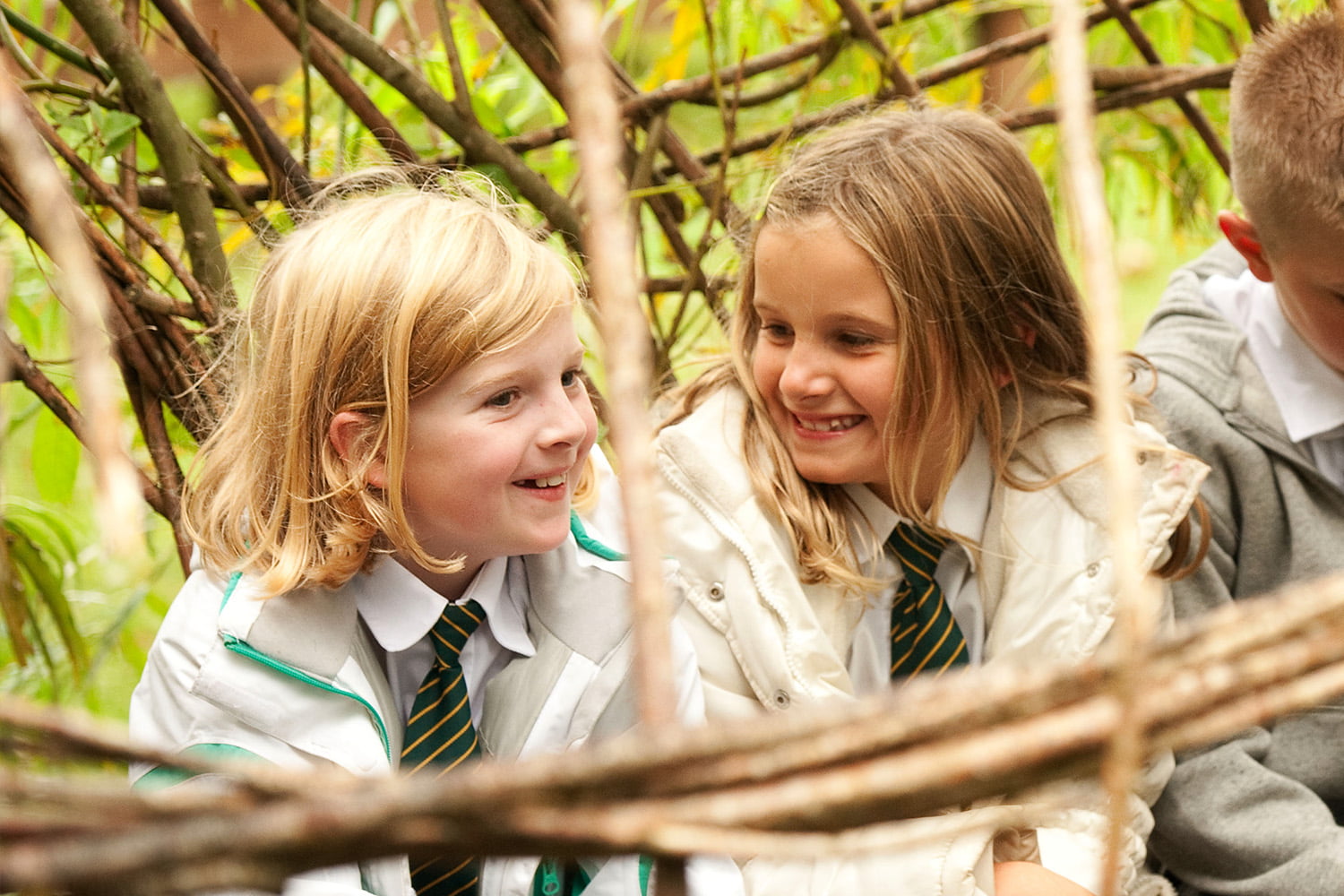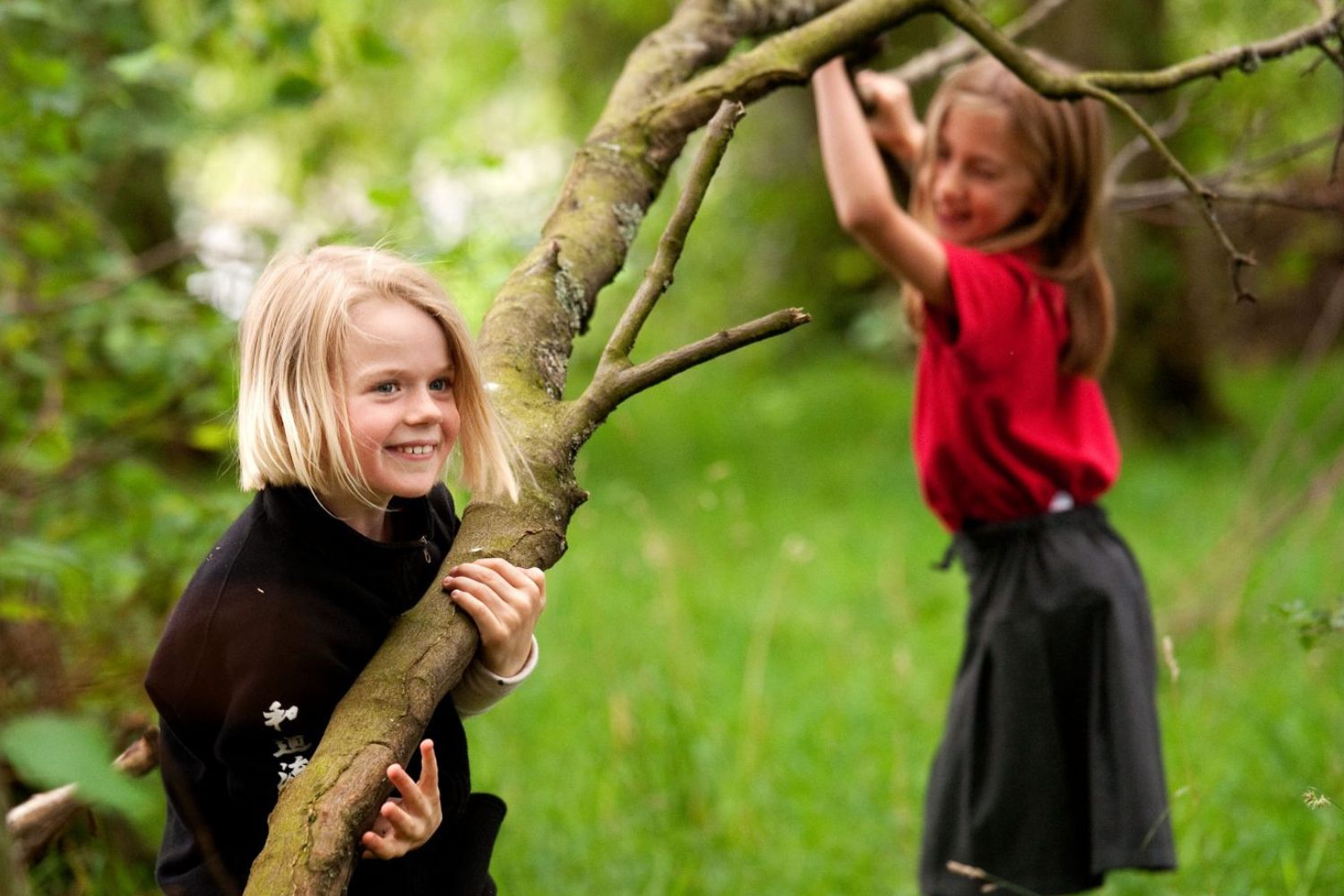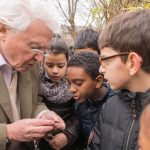Wellbeing: The impacts of outdoor learning and play
Discover what we’re doing to help children enjoy the wellbeing benefits of outdoor learning and play, and why they’re more important than ever before.
This spring, Learning through Landscapes celebrated its 35th anniversary, marking over three and a half decades of helping children to enjoy the benefits of outdoor learning and play. For more than 35 years, we’ve supported schools and early years settings to make the most of their outdoor spaces, enriching the curriculum, fostering a deeper connection to nature, and promoting good health and wellbeing for all learners.
We know that harnessing the benefits of the outdoor classroom is now more important than ever before. However, with every year that passes, at school and at home, children are spending less time outdoors. That’s why we’re working to make outdoor learning and play part of every school day, ensuring that more children can enjoy the far-reaching benefits.
In this post, we’re shining a spotlight on the impacts of learning and playing outdoors for wellbeing specifically. Join us as we take a deep dive into how outdoor learning and play support wellbeing at school, why the wellbeing benefits of learning and playing outdoors are increasingly important, and what Learning through Landscapes are doing to help.
The calming effect of connecting with nature
The wellbeing benefits of outdoor learning and play are deeply embedded, even before we bring out the outdoor lesson ideas. Research shows that even short periods spent in green spaces can lower levels of cortisol in the body, reducing stress and improving mood — and not just for children. When we asked educators why they choose to teach outdoors, several mentioned the personal benefit to their mental health and wellbeing. One teacher said:
Connecting with nature helps me to slow down in what is usually a fast-paced school environment. Taking the time to ‘notice nature’ is huge for my wellbeing and allows me to regulate and recalibrate in terms of stress levels.
Simply going outside is a low effort way to boost wellbeing for all. In an increasingly stressful and uncertain world, stepping back from our screens to enjoy the benefits of time in nature seems like it should be a priority. However, children (and adults!) are spending less time outdoors than ever before.
For many children, most of the time they spend outdoors is comprised of the time they spend learning and playing in the school grounds, making it even more important to get pupils out of the classroom at every opportunity. That’s why Learning through Landscapes are working to make outdoor learning and play part of every school day, ensuring that every child can enjoy the benefits of time outdoors.
Eliminating obstacles to getting outdoors
Long before embedding outdoor learning into the curriculum or adapting school grounds to the impacts of climate change, we know that simply stepping outside the classroom is a barrier to outdoor learning and play for many educators. From a lack of outdoor space to anxieties around managing pupil behaviour, there are several reasons educators might feel reluctant to take learning and play outdoors. We recognise this, which is why much of our work focuses on helping teachers to overcome that crucial first obstacle.
At its heart, Outdoor Classroom Day is simply about helping more children and young people to enjoy the benefits of spending more time outdoors at school. The global campaign seeks to celebrate and inspire outdoor learning and play, raising awareness of how easy (and enjoyable!) it is to take pupils out into the school grounds while building teacher confidence in the outdoor classroom.
The Learning in Local Greenspace project supported 115 schools in disadvantaged areas across Scotland to use nearby green spaces for outdoor learning, and the benefits to health and wellbeing were felt across the board. One teacher involved in the project said:
Sometimes the classroom can feel like a pressure cooker. Coming outside, I get to relax with the children, enjoy their company, and discover their personalities. It’s one of my favourite parts of the week.
Boosting social and emotional skills
Beyond improving wellbeing through simply spending more time in nature, outdoor learning and play provide several benefits that make them essential for healthy childhood development. Learning outdoors offers unique opportunities to embed knowledge and understanding while playing outdoors encourages socialisation and develops key skills, all of which improve self-esteem and confidence. Even at the most basic level, engaging in risky play provides children with a valuable opportunity to challenge themselves in a safe setting, setting them up to manage uncertainty better across all areas of their daily lives.
Outdoor learning and play create a positive feedback loop for children and young people, with the impacts felt both in and out of the classroom. That’s why, above all else, our work seeks to help teachers harness the full potential of the outdoors during their day to day lessons. Whether it’s through a training course or an outdoor lesson idea, empowering teachers to feel confident delivering the curriculum outdoors has measurable impacts on children’s wellbeing. Through the Local School Nature Grants project, we’ve provided thousands of schools across England, Scotland, and Wales with specialist training and resources to help them into the outdoor classroom. A grant recipient from a school in Birmingham told us:
Since developing our outdoor environment and teaching more lessons outside, we’ve already seen a very positive impact on the wellbeing of our reception children. They’ve made significant progress, particularly in their communication skills and in their own personal, social, and emotional development.
Getting children outdoors and on the move
Despite a wealth of evidence proving its benefits for our health and wellbeing, physical activity is on the decline, and this issue affects girls disproportionately. According to the World Health Organisation, 85% of adolescent girls do not meet daily physical activity recommendations, and their engagement with exercise and sport continues to decline as they grow older. Furthermore, less time outdoors and more time looking at screens is fueling an unprecedented surge in myopia rates.
However, not only does learning and playing outdoors naturally encourage more physical activity, improving mental health in turn, but research indicates that just two hours of daily outdoor activity can significantly reduce the risk of developing myopia. This means that taking even part of a lesson outdoors every day – by learning about the greenhouse effect through a game of climate change dodgeball, for example – could go a long way to improving the physical health of our children and young people.
Running, climbing, or even just exploring the school grounds during breaktimes can have a hugely positive impact. Even just getting muddy during early childhood can have a profound influence on health! However, knowing how to use outdoor learning and play to target specific benefits opens up even more opportunities. We know that children and young people have different needs, and the hands-on learning experience that outdoor lessons can provide may prove particularly beneficial for some.
Focusing on children who find the traditional classroom environment more challenging, This Place is Like a Building Site! saw pupils and their teachers working together on practical crafts in the great outdoors. They learned to recognise and manage risk, work as a team, and build personal resilience and self-esteem, all while physically moving their bodies and developing motor skills. However, one of the most pronounced benefits of the project according to teachers and pupils alike was the opportunities it provided for communication, collaboration, and connection. One pupil involved said:
These moments are quite valuable. We all want to do it and we all want to keep involved, so we’re willing to work together.
Communication, collaboration, and connection
Outdoor settings can flatten social hierarchies or even invert indoor dynamics entirely. It isn’t uncommon for a child who lacks confidence in the classroom to come out of their shell in an outdoor learning environment, unexpectedly taking the lead during a group activity, for example. Even just the unstructured nature of outdoor play provides opportunities for children to cooperate and negotiate with each other, learning to communicate and compromise, and allowing others to take the lead.
Despite the fact that playing outdoors exposes children to diverse experiences and encourages socialisation, the number of opportunities for play decline suddenly and significantly for pupils starting secondary school. The Better Breaktimes, Better Transitions project specifically sought to ease children through the tricky move from primary school to secondary school by providing opportunities to play outdoors, along with chances to make new friends at this crucial time in a young person’s life. One pupil involved said:
It was a good experience because some of the people that were doing it with me, I didn’t know. So, I’ve made new friends.
However, outdoor learning and play don’t just encourage socialisation between pupils. Educators who incorporate the outdoors into their practice report feeling more connected to their pupils, and these benefits even extend further, too. Through projects like Climate Ready School Grounds, we encourage pupils and their teachers to work with the whole school community, including parents and caregivers and even members of the local area, to make improvements to their outdoor spaces, because we know that school grounds are a hub not just for pupils during the day, but for the entire local community.
Building relationships in the school community
The My School, My Planet project provided valuable outdoor learning opportunities to children who typically spend the least time in nature, giving participating pupils the opportunity to make meaningful changes to their school grounds for the benefit of local wildlife, as well as the wider school community. A key focus of the project was helping children to build deeper relationships by working alongside community groups to make links between their own cultural heritage and their local area, including their school grounds.
Together, they shared ideas for planning changes based around the themes of climate change, soil health, and biodiversity, with the opportunity to gain firsthand knowledge about how climate change affects people in other countries or how local gardeners are adapting what they grow to support local wildlife. A staff member from a participating school said:
This project will certainly go some way to rebuilding the recent lost confidence of our children, enabling them to re-engage with their community through positive learning experiences.
What’s more, outdoor play in natural green spaces can serve as a way to support parent-child relationships and even safeguard the wellbeing of vulnerable pre-school children. The Nurturing Nature project trains early years practitioners and children’s service professionals to support children from families with complex needs, using local green spaces to facilitate play using free or ultra low-cost ideas. Delivered in areas of multiple deprivation, the project regularly receives fantastic feedback from participating families who experience the enjoyment, health benefits, and social breakthrough that playing in nature can bring.
Exploring more benefits of outdoor learning and play
Good health and wellbeing is the foundation for everything else, which is why the health and wellbeing benefits of outdoor learning and play are arguably the most important. Next time, we’ll explore how improved wellbeing interacts with the other key benefits our work at Learning through Landscapes provides, focusing on what we’re doing to support climate action and improve attainment through outdoor learning and play.
Sign up to our newsletter to stay up to date with the latest outdoor learning news and opportunities, or follow us on Bluesky, Facebook, and Instagram.












